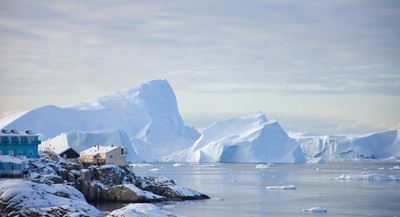
The melting of the Greenland ice sheet has the potential to increase global sea levels by tens of centimeters during this century. The exact amount depends on the surface melting which increases with global warming, and on the calving of icebergs where huge glaciers drain the interior icesheet.
By Ilona Mettiäinen, Vice-lead of the UArctic Thematic Network on Frozen Arctic Conservation, Researcher and John Moore, Lead of the UArctic Thematic Network on Frozen Arctic Conservation, Research Professor, Arctic Centre, University of Lapland
While Greenland has raised sea levels by about 0.5 millimetre per year over the past decades, it will be contributing ten or even a hundred times that by the end of the century. Knowing it is happening is one thing, but can we do anything about it? Reducing greenhouse gas emissions is clearly central to slowing surface melting, but that will not help with the ocean heat that has accumulated over the last century and will remain for long into the future. In a Nature article in 2018, our group suggested that limiting the access of deep warm waters to the important icesheet outlet glaciers might limit the acceleration in iceberg calving losses.
The Sermeq Kujalleq, or Jakobshavn Glacier as it is widely known, is the source of the breathtaking icebergs in the world-famous Ilulissat Icefjord in West Greenland. The glacier is the Arctic’s largest contributor to rising sea levels, adding four centimetres during the 20th century. A multidisciplinary research team led by professor John Moore from the Arctic Centre of the University of Lapland has studied ice sheet conservation by seabed anchored curtains in the Ilulissat Icefjord since 2021. This work has taken place under the GRISCO project (short for “Greenland ice sheet conservation as a community designed response to climate change - co-production of knowledge for ensuring sustainability”), funded by the Nordic Council of Ministers’ Arctic Cooperation Programme.
While the ultimate target in developing ice sheet conservation is to stabilize the enormous and highly vulnerable Thwaites Glacier - the “Doomsday Glacier” - in Antarctica, the Greenland outlets are technically less challenging. However, unlike Antarctica, Ilulissat has a thriving population. That is why in Greenland one cannot plan an intervention affecting the fjord and glacier without incorporating local sustainability aspects in the design, such as impacts on fishing and tourism livelihoods. Therefore, the big question is whether active conservation of the icesheet can be designed in a way that is also locally acceptable.
Ilulissat is Greenland’s 3rd largest town with 4,700 inhabitants, lots of fishermen, and a growing number of tourists. Ilulissat means icebergs in Greenlandic, and the first settlement Sermermiut and the iconic Icefjord are a UNESCO World Heritage Site. This means that its proactive conservation from the impacts of climate change is a duty of both Greenland and the international community as a whole.
The local significance of the Icefjord, the icebergs, and discovering which aspects define local acceptability and sustainability have been the focus of our research. This co-design process is emphatically not a straightforward consultation exercise. Public engagement and knowledge co-production has involved multidisciplinary work combining Arctic social sciences, natural sciences and Indigenous knowledge by collaborative methods. The process has included community workshops, school collaboration, art, interviews, and discussions with key organizations in Greenland during three research visits in 2021-2022.
The UArctic Frederik Paulsen High-level Seminar focusing on Greenland ice sheet conservation took place in Reykjavík, Iceland in October 2022 as a pre-event of the Arctic Circle Assembly. The seminar was the first major public activity of the newly established UArctic Thematic Network on Frozen Arctic Conservation. We gathered together glaciologists, environmental economists, and human geographers with Indigenous leaders from Greenland and deep-sea engineers.
The seminar has led to wider collaboration with the community, the Thematic Network, and with various NGOs. Prompted by community inputs, the engineers have been working on new “100% natural” solutions. Radical economic, policy, and legal proposals for financing interventions and providing governance frameworks designed to empower Greenland populations are being written. Moreover, an exhibition that came out of the Youth Science-Art workshop at a local school in Ilulissat is on display in Ilulissat and will be later transferred to the Arktikum Science Centre in Rovaniemi.
We intend to return to Greenland in 2023 to talk with people in Ilulissat and Nuuk, and to present our findings that address the knowledge needs raised in ongoing conversations with the locals. Decisions on actually doing any intervention await several years in the future, but it is important that Greenlanders have sufficient knowledge for making an informed decision when the time comes.